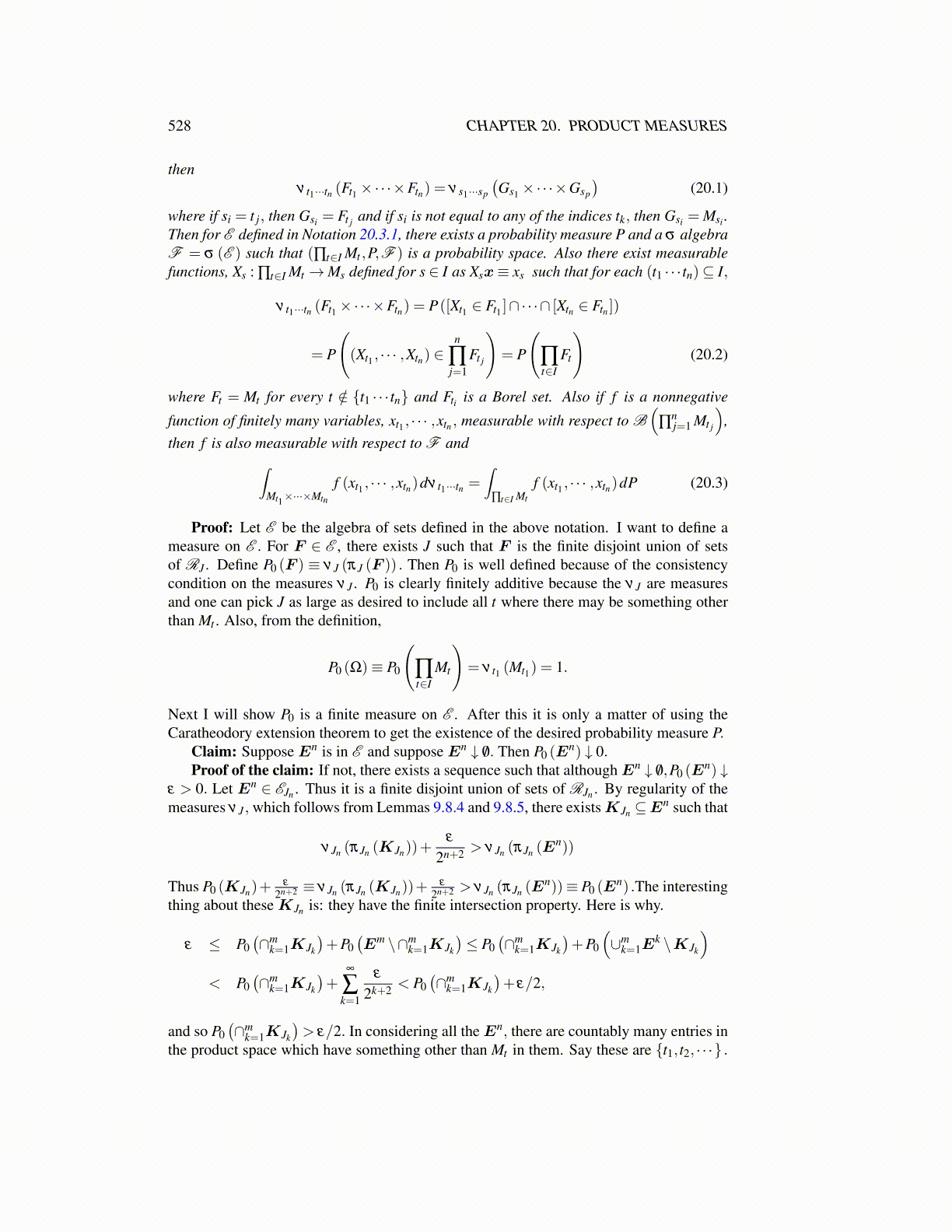
528 CHAPTER 20. PRODUCT MEASURES
thenν t1···tn (Ft1 ×·· ·×Ftn) = νs1···sp
(Gs1 ×·· ·×Gsp
)(20.1)
where if si = t j, then Gsi = Ft j and if si is not equal to any of the indices tk, then Gsi = Msi .Then for E defined in Notation 20.3.1, there exists a probability measure P and a σ algebraF = σ (E ) such that (∏t∈I Mt ,P,F ) is a probability space. Also there exist measurablefunctions, Xs : ∏t∈I Mt →Ms defined for s ∈ I as Xsx≡ xs such that for each (t1 · · · tn)⊆ I,
ν t1···tn (Ft1 ×·· ·×Ftn) = P([Xt1 ∈ Ft1 ]∩·· ·∩ [Xtn ∈ Ftn ])
= P
((Xt1 , · · · ,Xtn) ∈
n
∏j=1
Ft j
)= P
(∏t∈I
Ft
)(20.2)
where Ft = Mt for every t /∈ {t1 · · · tn} and Fti is a Borel set. Also if f is a nonnegative
function of finitely many variables, xt1 , · · · ,xtn , measurable with respect to B(
∏nj=1 Mt j
),
then f is also measurable with respect to F and∫Mt1×···×Mtn
f (xt1 , · · · ,xtn)dν t1···tn =∫
∏t∈I Mt
f (xt1 , · · · ,xtn)dP (20.3)
Proof: Let E be the algebra of sets defined in the above notation. I want to define ameasure on E . For F ∈ E , there exists J such that F is the finite disjoint union of setsof RJ . Define P0 (F ) ≡ νJ (πJ (F )) . Then P0 is well defined because of the consistencycondition on the measures νJ . P0 is clearly finitely additive because the νJ are measuresand one can pick J as large as desired to include all t where there may be something otherthan Mt . Also, from the definition,
P0 (Ω)≡ P0
(∏t∈I
Mt
)= ν t1 (Mt1) = 1.
Next I will show P0 is a finite measure on E . After this it is only a matter of using theCaratheodory extension theorem to get the existence of the desired probability measure P.
Claim: Suppose En is in E and suppose En ↓ /0. Then P0 (En) ↓ 0.
Proof of the claim: If not, there exists a sequence such that althoughEn ↓ /0,P0 (En) ↓
ε > 0. Let En ∈ EJn . Thus it is a finite disjoint union of sets of RJn . By regularity of themeasures νJ , which follows from Lemmas 9.8.4 and 9.8.5, there existsKJn ⊆En such that
νJn (πJn (KJn))+ε
2n+2 > νJn (πJn (En))
Thus P0 (KJn)+ε
2n+2 ≡ νJn (πJn (KJn))+ε
2n+2 > νJn (πJn (En))≡ P0 (E
n) .The interestingthing about theseKJn is: they have the finite intersection property. Here is why.
ε ≤ P0(∩m
k=1KJk
)+P0
(Em \∩m
k=1KJk
)≤ P0
(∩m
k=1KJk
)+P0
(∪m
k=1Ek \KJk
)< P0
(∩m
k=1KJk
)+
∞
∑k=1
ε
2k+2 < P0(∩m
k=1KJk
)+ ε/2,
and so P0(∩m
k=1KJk
)> ε/2. In considering all theEn, there are countably many entries in
the product space which have something other than Mt in them. Say these are {t1, t2, · · ·} .